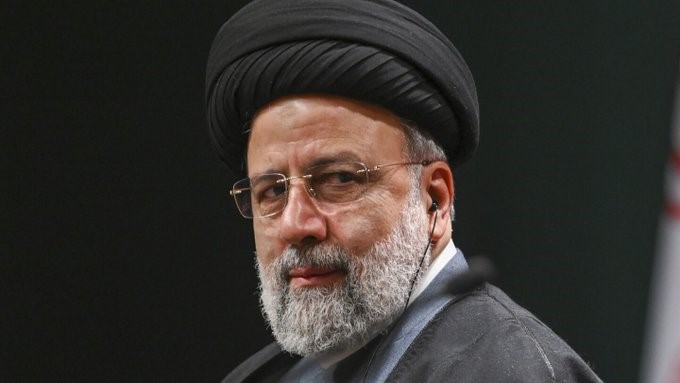JON GAMBRELL
Iranian President Ebrahim Raisi, a hard-line protégé of the country’s supreme leader who helped oversee the mass executions of thousands in 1988 and later led the country as it enriched uranium near weapons-grade levels and launched a major drone-and-missile attack on Israel, has died. He was 63.
Raisi’s sudden death, along with Iran’s foreign minister and other officials in the helicopter crash Sunday in northwestern Iran, came as Iran struggles with internal dissent and its relations with the wider world. A cleric first, Raisi once kissed the Quran, the Islamic holy book, before the United Nations and spoke more like a preacher than a statesman when addressing the world.
Raisi, who earlier lost a presidential election to the relatively moderate incumbent Hassan Rouhani in 2017, ended up coming to power four years later in a vote carefully managed by Supreme Leader Ayatollah Ali Khamenei to clear any major opposition candidate.
His arrival came after Rouhani’s signature nuclear deal with world powers remained in tatters after then-President Donald Trump unilaterally withdrew America from the accord, setting in motion years of renewed tensions between Tehran and Washington.
But while saying he wanted to rejoin the deal, Raisi’s new administration instead pushed back against international inspections, in part over an ongoing suspected sabotage campaign carried out by Israel targeting its nuclear program. Talks in Vienna at restoring the accord remained stalled in his government’s first months.
“Sanctions are the U.S.’ new way of war with the nations of the world,” Raisi told the United Nations in September 2021.
He added: “The policy of ‘maximum oppression’ is still on. We want nothing more than what is rightfully ours.”
Mass protests swept the country in 2022 after the death of Mahsa Amini, a woman who had been detained over allegedly not wearing a hijab, or headscarf, to the liking of authorities. The monthslong security crackdown that followed the demonstrations killed more than 500 people and more than 22,000 others were detained.
In March, a United Nations investigative panel found that Iran was responsible for the “physical violence” that led to Amini’s death.
Then came the 2023 Israel-Hamas war, in which Iranian-backed militias targeted Israel. Tehran launched an extraordinary attack itself on Israel in April, in which hundreds of drones, cruise missiles and ballistic missiles fired. Israel, the U.S. and its allies shot down the projectiles, but it showed just how much the yearslong shadow war between Iran and Israel had boiled.
Khamenei appointed Raisi, a former Iranian attorney general, in 2016 to run the Imam Reza charity foundation, which manages a conglomerate of businesses and endowments in Iran. It is one of many bonyads, or charitable foundations, fueled by donations or assets seized after Iran’s 1979 Islamic Revolution.
These foundations offer no public accounting of their spending and answer only to Iran’s supreme leader. The Imam Reza charity, known as “Astan-e Quds-e Razavi” in Farsi, is believed to be one of the biggest. Analysts estimate its worth at tens of billions of dollars as it owns almost half the land in Mashhad, Iran’s second-largest city.
At Raisi’s appointment to the foundation, Khamenei called him a “trustworthy person with high-profile experience.” That led to analyst speculation that Khamenei could be grooming Raisi as a possible candidate to be Iran’s third-ever supreme leader, a Shiite cleric who has final say on all state matters and serves as the country’s commander-in-chief.
Though Raisi lost his 2017 campaign, he still garnered nearly 16 million votes. Khamenei installed him as the head of Iran’s internationally criticized judiciary, long known for its closed-door trials of human rights activists and those with Western ties. The U.S. Treasury in 2019 sanctioned Raisi “for his administrative oversight over the executions of individuals who were juveniles at the time of their crime and the torture and other cruel, inhuman, or degrading treatment or punishment of prisoners in Iran, including amputations.”
By 2021, Raisi became the dominant figure in the election after a panel under Khamenei disqualified candidates who posed the greatest challenge to his protege. He swept nearly 62% of the 28.9 million votes in that vote, the lowest turnout by percentage in the Islamic Republic’s history. Millions stayed home and others voided ballots.
Raisi was defiant when asked at a news conference after his election about the 1988 executions, which saw sham retrials of political prisoners, militants and others that would become known as “death commissions.”
After Iran’s then-Supreme Leader Ayatollah Ruhollah Khomeini accepted a U.N.-brokered cease-fire, members of the Iranian opposition group Mujahedeen-e-Khalq, heavily armed by Saddam Hussein, stormed across the Iranian border from Iraq in a surprise attack. Iran blunted their assault.
The trials began around that time, with defendants asked to identify themselves. Those who responded “mujahedeen” were sent to their deaths, while others were questioned about their willingness to “clear minefields for the army of the Islamic Republic,” according to a 1990 Amnesty International report. International rights groups estimate that as many as 5,000 people were executed. Raisi served on the commissions.
“I am proud of being a defender of human rights and of people’s security and comfort as a prosecutor wherever I was,” Raisi said.
Born in Mashhad on Dec. 14, 1960, Raisi was born into a family that traces its lineage to Islam’s Prophet Muhammad, marked by the black turban he would later wear. His father died when he was 5. He would go onto the seminary in the Shiite holy city of Qom and later would describe himself as an ayatollah, a high-ranking Shiite cleric.
He is survived by his wife and two daughters.
AP

